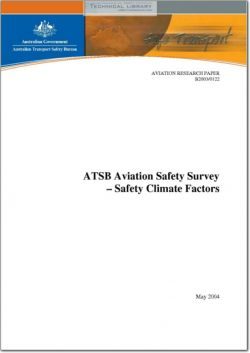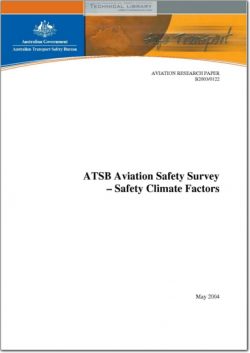ATSB-B2003-0122

- Version
- 169 Downloads
- 732.57 KB File Size
- 1 File Count
- August 9, 2016 Create Date
- August 9, 2016 Last Updated
ATSB Aviation Safety Survey - Safety Climate Factors

The aim of this study was to investigate the safety climate1 of Australian aviation as
perceived by commercial pilots. To do this, the ATSB sent a survey to 5000
commercial pilots throughout Australia. The survey had two parts: one was a safety
climate scale and the other asked about safety experiences during the last year.
Demographic information was also sought. This report is limited to the demographic
data and the first part of the survey, the safety climate scale.
The report explores the demographic data of age, hours flown, employment basis
(full-time, part-time etc) and size of organisation, measured by the number of full-
time pilots employed. Charter and aerial work pilots had similar profiles on these
characteristics while Regular Public Transport (RPT) pilots showed many differences
from the other two groups. The demographic data also sought information on stability
characteristics of the company that the pilot had worked for during the past year. This
information also yielded interesting comparisons between the three groups — RPT,
charter and aerial work.
Safety climate perceptions are also reviewed. The safety climate instrument was
developed as a generic measure of safety climate for the transport sector. Use of this
measure with an aviation sample revealed four factors of safety climate important to
aviation — management commitment, training, equipment and maintenance and rules
and procedures. Graphs of each factor by flying category (RPT, charter and aerial
work) are presented. Most respondents either agreed 0r strongly agreed that the
aspects of safety measured were present in the industry.
Finally, the flying category groups (RPT, charter, aerial work) were tested for
statistically significant differences across the four safety climate factors. No
differences were found among the groups, indicating that it is likely that there is an
industry—wide professional safety climate for pilots as a professional group.
| File | Action |
|---|---|
| ATSB-B2003-0122 ATSB Aviation Safety Survey - Safety Climate Factors.pdf | Download |

Comment On This Post